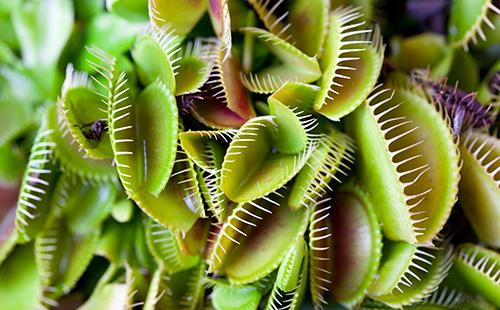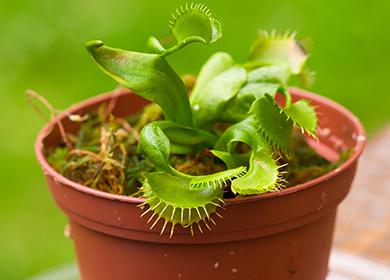The content of the article
The botanical name for the venus flytrap is dionea. This is a difficult and moody flower. The plant is popular among flower growers because of its exoticism and dissimilarity to other crops.
Venus Venus Flytrap, or Dionaea Muscipula - Latin name dionaea muscipula - noble flycatcher and fly-eater. If such a plant has appeared in your home, you should know that this is not a cactus - it won’t cost you one watering every five years. She is indeed a fly-eater, in the absence of insects in her access for eating ... she will have to be fed! I don’t know what ... or by whom the goddess Venus fed her, in whose honor the plant got its name, but what will you feed her if the flies in your house run out - read in our article.
Description and interesting features
Dionea is a perennial herbaceous plant predator. Belongs to the family of sundews, only one species is included in the genus. The size is small - no more than 15 cm for an adult plant. The stem is bulbous. During flowering, produces a high peduncle crowned with an inflorescence of the corymbose type of white flowers.
In the natural environment it grows on nitrogen-poor soil. It receives the necessary substances through the capture and processing of insects. The stem is short, located underground. A rosette is formed from several leaves - from four to seven. Traps up to 15 cm tall, reddish inside, bivalves, with sparse setae on the outer edge.
The inner surface of the trap is equipped with glands that produce a kind of nectar to attract prey. For the closure of the trap, special sensitive hairs respond, responding to the movement of the insect. After the cusps are closed, digestive enzyme production begins. Digesting food can take up to ten days, then the trap opens. After digesting the third insect, the trap dies.
Care for a Venus flytrap: what a grower needs to know
Caring for a dionea at home is completely different from growing other indoor flowers. This is a special plant, and he needs constant care.
- Lighting. Need bright light and sun, at least four hours a day. Keeping the dione in the shade is not recommended. It is desirable to plant it in a container of light color: in dark pots, the roots overheat, and the plant dies. It is better to choose the south window, east and west are also allowed. The room should be regularly ventilated - the dionea cannot stand air stagnation. In summer you can rearrange it on the balcony - on the street the “predator” grows better, finds food for itself. With a reduction in daylight hours, additional illumination with fluorescent lamps is arranged.
- Temperature. The optimum temperature for growing dionea is 22–27 ° C. Withstands higher drops, up to 35 ° C. Prefers fresh air, but is afraid of drafts.
- Humidity. It does not need spraying, it feels good in the humidity range from 40 to 70%.
- Watering. You need to water the venus flytrap correctly. Particular attention should be paid to the composition of the water. For dionea any impurities are harmful. The water is boiled and filtered. The best option is distilled water. Watering frequency is determined by the moisture level of the topsoil. When it dries, the plant is carefully watered, but not very abundantly. Preference is given to lower watering through the pan.
- The soil. Soil is prepared for dionea on the basis of high peat, mixing it with the same amount of perlite or sand. Perlite is preferred - due to its hygroscopicity, it prevents the occurrence of rot. Perlite is soaked for a week before use in distilled water, while sand is boiled in advance.
- Transfer. It’s easy to transplant a Venus flytrap into another pot. Transshipment is done no more than once every three years if the root system is too large. No need for frequent transplants. The soil with the correct composition of water does not saline, the need for organic matter and trace elements in dionea is absent.
Menu for Dionea
Sometimes it is necessary to feed the venus flytrap with insects. The need for organic food in a predatory plant arises only with a lack of nitrogen. They feed live insects - flies, mosquitoes, spiders. Sensitive hairs fix movement, and the trap closes. The "predator" rarely feeds - usually once a month.
Do not feed the dionea with oversized insects, experiment with food crumbs. Each time, feeding is carried out in different traps. After opening the trap, food debris must be carefully removed to avoid decay.
In winter, there is no need for food. Also, the plant ceases to catch prey and process the proposed food in stressful situations. Excess nitrogen negatively affects the condition of the leaves - the dionea begins to fade, turn yellow. Therefore, trying to feed her by force is not worth it.
For three to four months, a dormant period lasts, so you need to know how to care for a venus flytrap in winter. The dione is kept at low temperatures, not higher than 10 ° C. From the end of September, feeding is stopped.
Breeding methods
You can propagate dionea with a peduncle or children. Seeds are rarely used, due to the complexity of growing.
Kids
Dionea quite actively forms children. You can separate them during the next transplant. Too often, a venus flytrap cannot be disturbed - it prefers to grow up in a large "family".
The roots of the dionea are fragile, they separate the children very carefully - the damaged root system makes it difficult to adapt in a new pot. Use only with a sharp knife. Sections after division must be disinfected - treated with fungicide and coal powder.
Peduncles
For propagation by a peduncle, you do not need to wait until it reaches full height. The flower stalk is cut off at the initial stage of growth - at a size of about 4–5 cm. A small container is filled with wet peat, the flower stalk is buried in it by 1 cm. Top is covered with a plastic glass or a jar.
Root and form a young shoot of the peduncle will be long.Before the shoots appear, the greenhouse is aired, but the shelter is not removed for a long time. The soil is periodically moistened, even its short-term drying out is not allowed.
Seeds
Growing a venus flytrap from seeds is a long and complicated process. Fresh seeds do not give seedlings - they need preliminary stratification, that is, prolonged soaking, keeping at certain temperatures.
For stratification, a tissue napkin is impregnated with a solution of the “Topaz” preparation; Dionea seeds are wrapped in a napkin, packed in a plastic bag and put in the refrigerator. Fresh seeds must be kept in the refrigerator for a month or two, collected long ago - one and a half to two months.
Weekly seeds are taken out and inspected. When mold appears, they are washed in a solution of Topaz. The solution is prepared only from distilled cold water at about the same temperature at which stratification occurs. After stratification, you can start sowing seeds. Germinate them in the following sequence.
- Sowing. Seeds are sown in pre-sterilized, fungicide-treated peat. You do not need to deepen the seeds, just sprinkle with a thin layer of peat.
- Film coating. The container with crops is covered with a film, put in a warm, sunny place. In a shaded area, backlighting with fluorescent lamps is required. For fast germination, the temperature is maintained at a level of 25–27 ° С.
- Ventilation. Every day, the edge of the film is slightly bent for ventilation. Accumulated condensate is cleaned from time to time. Shoots appear in two to three weeks. Sometimes germination is delayed up to a month.
- Transfer. For five months, seedlings will develop, then growth will slow down. If by this moment it is still far from wintering, you need to transplant the dione into another pot, thoroughly washing the roots from the old peat. Distilled water is used for washing.

Possible growing problems
Dionea is a specific plant, therefore, even the experienced florist is not immune from mistakes in the initial stages of cultivation. Improper feeding, inappropriate conditions of detention - all this can lead to a number of problems. All of them are described in detail in the table.
Table - Problems of growing dionea
| External manifestations | Cause | Care Adjustment |
|---|---|---|
| Individual traps turn black | - Feeding too large insects; - excess watering, decay | - The blackened trap is cut off; - watering is suspended until the soil dries |
| Leaves turn yellow but do not die | - High salt hard water | - Transplanted to a new peat; - watered only with distilled or boiled water |
| Leaves turn yellow and die | - Increased nutrient content in the soil; - fertilizer application | - transplanted into a new substrate |
| Traps do not form | - lack of light | - The dione is rearranged in a more lighted place or illuminated by fluorescent lamps |
| Traps dry out | - The natural process of dying off a trap after two or four slams | - Cut off the drying trap |
| Brown spots appear at the ends of the leaves | - Sunburn; - the application of organic or mineral fertilizers | - Shade from the direct sun on the south side; - spill the soil with distilled water to remove excess substances |
Frequent diseases, their treatment
Dionea is mainly affected by bacterial and fungal diseases. The main causes are rotting food debris, excessive soil moisture. A description of common diseases and methods for their treatment can be found in the table.
Table - Disease Diseases
| Disease name | External manifestations | Treatment |
|---|---|---|
| Black soot fungus | - Black spots appear on leaves after pest damage | - Spray the plant and soil with a solution of fungicide "Topaz" |
| Gray rot | - Gray fluffy coating appears on the leaves | - Cut the affected leaves: - sprayed with fungicide |
| Bacterial rot | - The closed trap with insects decays | - The decayed trap is cut, the cut is treated with carbon powder |
Common pests and their control
Even a predatory plant that feeds on insects can be affected by some pests. This is explained by their small size - dionei traps do not pose a danger to aphids or spider mites. Pests that can attack the dionea, and ways to deal with them are described in the table.
Table - Dionea Pests
| Pest name | Signs of defeat | Methods of struggle |
|---|---|---|
| Spider mite | - Small bright spots appear on the leaves; - leaves turn yellow and fade; - a thin web forms on the back of the leaves | - Increase humidity in the room; - sprayed with the drug "Actellik" or "Vermitek" |
| Aphid | - Colonies of small green insects form; - the leaves are covered with a sticky sugar coating; - petioles of the leaves are deformed | - The affected leaves are carefully washed with soapy water; - carry out spraying with the drug "Fitoverm", "Actofit" |
| Mealybug | - The leaves are covered with a whitish waxy coating; - light lumps resembling cotton wool appear on the plant | - Repeatedly sprayed with any insecticide - Fitoverm, Inta-Vir |
The unusual “predatory” flower looks decorative and extravagant, it is interesting to observe it, especially during feeding. Since you need to take care of the venus flytrap in a special way, before buying it is worthwhile to carefully study the information about the contents and cultivation of the plant.

